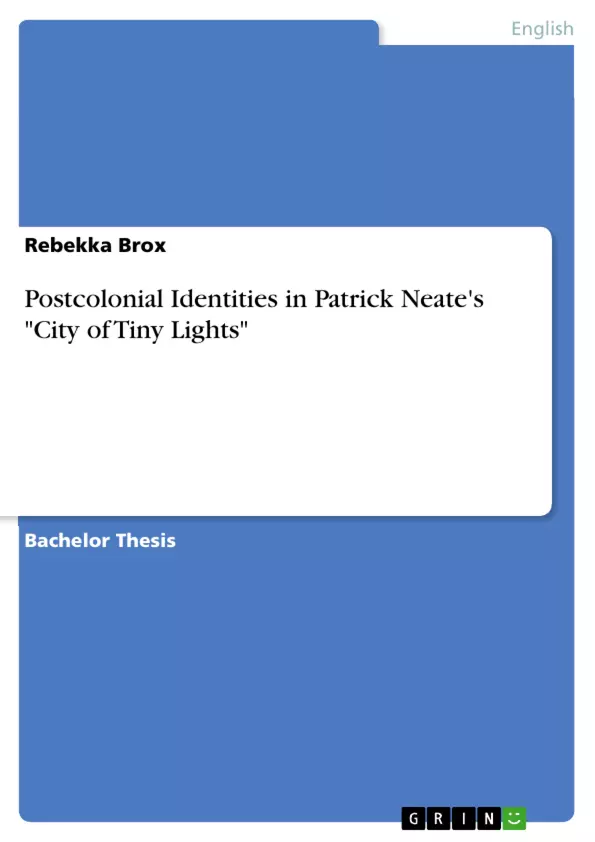Firstly, this paper focuses on Farzad and his self as a “contrary geezer”. As a first step it is analysed in what respect Farzad can be described as a man living in diaspora. Subsequently, it is shown what special position Uganda acquires in his life. By applying Salman Rushdie’s theory of imaginary homelands the paper demonstrates how Farzad uses imagination in order to cross space and time to return to his deceased wife. The means for this return are alcohol and painting. The latter is examined in more detail showing its significance for Farzad’s life. Finally, Farzad’s obsession for cricket and its implications are interpreted. Secondly, the character of Gundappa is introduced who has quite a peculiar way of dealing with his identity issue. It is shown what massive effect the death of his mother has on him and his self-perception and how this finally leads to the abandonment of his real identity. It is analysed how and why he he starts disguising as someone who he is not and creates several new identities. Thirdly, the paper has a closer look on the main protagonist Tommy. This part starts out with Tommy’s time as a terrorist showing how the death of his mother led to a similar but slightly different reaction as the one of his brother Gundappa and how he ends up being a man without an identity. Furthermore, the recurring flashbacks are analysed with special attention to his distanced relationship to this time as a soldier of the Mujahideen. It is depicted in what respect this still influences his life. Next, it is described how he regains and accepts his identity. Applying postcolonial scholar Homi K. Bhaba’s theories of ‘living in-between’ and mimicry to Tommy it is shown how he realises that he will never be regarded as a pure Englishman by society. Instead, he accepts the multitude of cultures that influence his identity and finds himself living at the border of different cultures shuttling from one to the other and using the possibilities that this shuttling between cultures offers. As a further step this theory of living at a border is transferred to his occupation as private investigator. Furthermore, the influence that his ethnicity has on his occupation is examined and whether he can sustain his aspiration of acting in the tradition of Chandler’s crime novel figure Philip Marlowe. Finally, Tommy’s language is considered as a means of expressing identity.
Inhaltsverzeichnis (Table of Contents)
- Introduction
- Farzad A Character Looking Back to the Past.
- Farzad and Painting
- Farzad and Cricket
- Gundappa Forging Identity
- Tommy - Abandoning and Regaining Identity
- Tommy Living 'In-Between'
- Tommy's Self as Private Investigator
- Tommy and Language
- Conclusion
Zielsetzung und Themenschwerpunkte (Objectives and Key Themes)
This paper aims to analyze how postcolonial identities are constructed in Patrick Neate's novel City of Tiny Lights through the lens of the three main characters, Farzad, Gundappa, and Tommy. The novel explores the complex interplay of cultural and historical experiences, particularly in the context of Ugandan-Indian-Pakistani diasporic communities in Britain.
- The impact of migration and diaspora on identity formation
- The role of memory and imagination in shaping identity
- The negotiation of multiple cultural influences and belonging
- The concept of "living in-between" and the acceptance of hybrid identities
- The influence of language on identity and self-expression
Zusammenfassung der Kapitel (Chapter Summaries)
The introduction sets the stage for the exploration of identity in the context of postcolonial migration. It highlights the significant presence of individuals of non-white origin in the UK, particularly those of Asian descent, and the need to understand their experiences.
Chapter 2 focuses on Farzad, examining his diasporic identity as a "contrary geezer" and exploring his complex relationship with his heritage, including Uganda's role in his life. The chapter delves into Farzad's use of imagination and his attempts to return to his deceased wife through alcohol and painting.
Chapter 3 introduces Gundappa, who grapples with identity issues stemming from the death of his mother. This chapter analyzes his self-perception and his eventual abandonment of his real identity, leading him to create various new identities.
Chapter 4 delves into the main protagonist, Tommy, starting with his time as a terrorist and his distant relationship with his past as a soldier of the Mujahideen. The chapter examines how these experiences influence his present life and how he ultimately regains and accepts his identity. It explores Tommy's experience of "living in-between" and how he accepts the multitude of cultures that shape his identity.
Schlüsselwörter (Keywords)
Postcolonial identity, diaspora, migration, cultural hybridity, "living in-between", mimicry, imagination, memory, language, belonging, difference, Ugandan-Indian-Pakistani heritage.
- Citar trabajo
- Rebekka Brox (Autor), 2009, Postcolonial Identities in Patrick Neate's "City of Tiny Lights", Múnich, GRIN Verlag, https://www.grin.com/document/141465



